Recommended Varieties/Cultivars
Detroit Dark Red is a reliable, versatile, heat-tolerant, longtime favorite heirloom variety that can be harvested both when small for baby beets or when fully mature for medium-to-large red globe roots. It sprouts well during cool to cold weather.
Other recommended varieties include Ruby Queen, a youngish heirloom introduced in 1957 that produces uniform, tender, and sweet roots, and tolerates poor soils better than many other beet varieties; Little Ball, grown as a gourmet baby beet; Early Wonder, an heirloom grown especially for early greens; Burpee Red Ball, a spinach beet grown for its greens; and Burpee’s Golden Beet, an heirloom grown for both its greens and its sweet roots with milder flavor.
Bull’s Blood Beet is an interesting, heat-and-cold-tolerant heirloom often grown for its strikingly dark red-purple-to-burgundy leaves, whose color intensifies as the foliage ages. Bull's Blood Beet (say fast 10 times for tongue-twisting gardening entertainment) leaves provide beauty and contrast in the vegetable garden and salads, and often provoke compliments and conversation. If harvested early as baby beets, the roots are especially tasty and tender.
Golden Boy Beet has a lovely buttery yellow color and a sweet, mild flavor. Chioggia or Di Chioggia is an Italian heirloom famous for its striped red-and-white interior, sweet, mild taste, and early maturation (50 to 55 days).
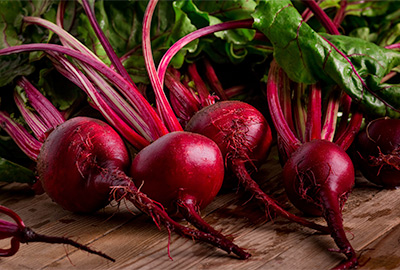
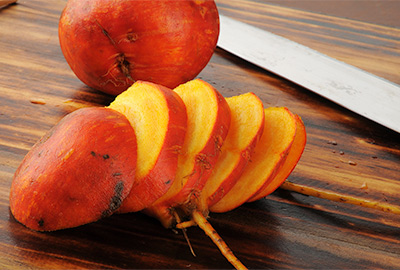
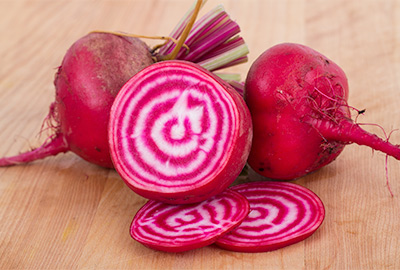
Can't decide? Try Gourmet Blend including Detroit Dark Red, Chioggia and Golden Beet.
Buying/Selection Tips
Beets should generally be seeded directly outdoors. GardenZeus recommends against starting transplants or purchasing beet starts for transplant, as transplanted beets may be more prone to poor root formation, poor yield, diseases, pests, and other problems.
Some nurseries may happily sell you cell packs or transplants of lush-looking beet seedlings, but these nearly always will result in a disappointing harvest of lesser-quality roots.
Beets can technically be transplanted successfully within the first few weeks after germination; this is generally recommend for skilled biointensive gardeners and experienced gardeners willing to start their own seeds, observe starts carefully, and time transplanting precisely.
Soil Needs/Tip
To form attractive, sizable roots, beets need loose, uniform, evenly textured, friable, uncompacted soil without rocks or other obstructions to at least two to three times the expected depth of the beet roots. Typically beets will grow forked, tough, or small roots in compacted and obstructed soils.
Beets prefer soil that is fertile; with moderate but not too much nitrogen; with sufficient phosphorous, potassium, magnesium, sulfur, and boron; with pH between 6.5 and 7.0; and with moderate-to-high organic matter. Sandy loam is the ideal soil type for growing beets. They tolerate and produce reasonably well in soil pH of 6.0 to 7.2 and in a wide range of soil textures. Harvesting is more difficult in clay and heavy soils.
Beet growth may be stunted in very acid (low pH) soil or in soils deficient in boron. Consider growing beets in raised beds or large containers on sites with compacted soils or poor drainage.
Suitable Microclimate
Beets prefer full sun at cool temperatures from 50 to 65° F, although warmer temperatures are better for germination. They produce best when shaded during hot afternoons. In part shade, beets may not perform well, and may produce fewer and smaller leaves, and smaller roots.
Getting Started
Beets are a colorful, interesting, fun vegetable to grow. They generously and efficiently offer two crops from one plant: leaves and roots.
Beets are unusual among garden seeds in that, like chard, they are polyembryonic, meaning that one seed contains multiple baby plants, and can produce multiple beet plants, usually 1 tor 3 per seed, but for some seeds as many as 5.
For continuous harvest, GardenZeus expert Darren Butler recommends a simple successive planting plan with beets: estimate how many beets you use or need every 2 to 3 weeks, then start about twice that many seeds every 2 to 3 weeks throughout the growing season. After losing a portion of your plants to thinning, pests, diseases, inattention or overattention, and garden mishaps, you should have a steady and sufficient supply of fresh garden beets and/or greens plus hopefully extras to harvest as baby beets or give away to family and friends.
Watering Tips
Beets prefer uniformly moist but not wet soil, and they need moisture to form tender, palatable roots; they are not a drought-tolerant vegetable. Do not allow soil to dry between waterings. Overwatering or wet soil may result in tough or woody roots, overly red leaf color, shallow rooting, and/or rotting or diseased roots. Underwatering or soil dryness between waterings may result in poor root formation or split roots.
Planting Method/Tips
Beet seeds are large enough to plant by hand and should generally be seeded directly outdoors. Optimal soil temperatures for germination of most beet varieties are 50° to 80° F. Beets will germinate more slowly and variably at temperatures from 41° F to 95° F.
Beet seeds should remain consistently moist but not wet to germinate well, which may require misting or watering with a gentle, fine spray two or more times per day. Wet soil makes it more likely that both seedlings and established beets will succumb to diseases.
Beets can technically be transplanted successfully within the first few weeks after germination; this is generally recommended for skilled biointensive gardeners and experienced gardeners willing to start their own seeds, observe starts carefully, and time transplanting precisely.
Spacing
Plant beet seeds about 1/2 inch deep, spaced 1 to 2 inches apart. Thin smaller and weaker seedlings, leaving the stronger and more vigorous plants in a final spacing of 4 to 5 inches apart, or plant here and there among onions, kohlrabi, greens, or strawberries.
Because beets are polyembryonic, more than one plant may sprout from a single seed, so it's best to cut thinnings at soil level with garden scissors or snips rather than pulling the young starts, which might disturb or even uproot the beets you want to keep. Use thinned plants for early salads, sandwiches, and garnishes.
It is important to thin beets because sufficient spacing is needed for beets to produce healthy, nicely shaped roots. When beets are grown too close to each other, roots may not form properly or may become tough and fibrous, and the plants may be more prone to pest and disease infestation.
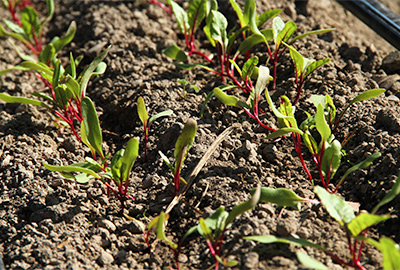
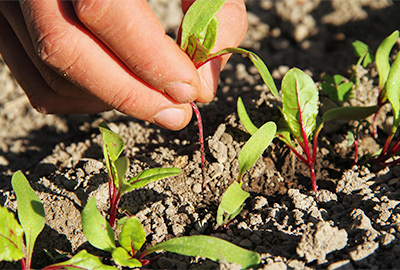
Timelines
3 to 10 days or longer to seed germination (may take 2 weeks or longer during cool weather).
Bioiontensive and skilled gardeners may wish to transplant seedlings 2 to 4 weeks after germination.
Early harvest of small leaves and thinned plants may begin within 10 to 30 days of germination.
Harvest of baby beet roots and mature leaves within 20 to 40 days of germination.
50 to 70 days from germination to harvest of full roots, depending upon variety and growing conditions.
Pollination Needs/Tips
Because we eat the roots and leaves of beet plants, we prefer slow flowering (slow bolting), and are not concerned with pollination unless saving seeds.
If growing beets for seed saving, they can be planted closer together than when being planted for root harvest.
Interplanting/Companion Planting
Beets should not be planted near runner and pole beans, as these garden antagonists are believed to stunt each others' growth. Beets have few other antagonist plants in the vegetable garden, and do well when planted with many other vegetables. Traditional companions include onions, other alliums, greens, and kohlrabi. Planting sparsely among more dense onions or other alliums may provide mild discouragement for slugs, snails, and insect pests.
Nutrient/Amendment/Fertilization Needs/Tips
Beets do best in soil that is fertile, with moderate but not too much nitrogen, and with sufficient boron, phosphorous, potassium, magnesium, and sulfur. In new gardens and every few years in established gardens, or when having plant problems that might be related to soil deficiencies or toxicities, have a professional lab test done of your soil to know the mineral composition. This is generally more important for growing highly nutritious vegetables such as beets than it is for less-nutritious vegetables, such as lettuce.
Unless your soil is already high in nitrogen, GardenZeus recommends adding nitrogen in the form of diluted urea or a cup of chicken manure diluted in 4 gallons of water (half cup if fresh manure) and mixed thoroughly after seedlings are 2 to 3 inches tall and about once per month thereafter, or twice per month if growing beets primarily for leaves. Adding too much nitrogen may result in lush, high-carbohydrate leaves that attract insect infestation, and may result in leafy beets with small roots.
Mulching
Use a quarter to half-inch fine mulch for small starts under 4 inches in height; increase to half-an-inch or more of fine to medium mulch after plants are 6 to 10 inches tall.
Pruning/Cutting Back/Pinching/Separating
GardenZeus generally recommends harvesting outer leaves of beet as needed, which allows the plant to produce new leaves over an extended period from the growing point at the plant's center.
Propagating
From seed. GardenZeus generally recommends open-pollinated, untreated, organically grown seeds.
Container Gardening
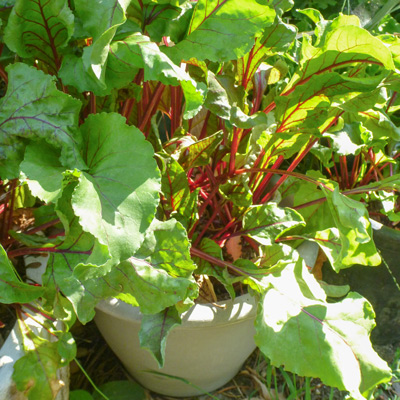
Beets are well suited for growing in containers, especially baby beets, either varieties specifically bred to be harvested small, such as Little Ball, or any beet variety harvested early.
For baby beets, use a container that is at least 12 inches deep. For growing beets to maturity in containers, GardenZeus recommends containers at least 18 inches deep. Use soil that is free of stones and obstructions, with moderate organic matter. GardenZeus recommends a soil mix of at least 50% sand when growing beets in containers. Potting soils with extremely high proportions of organic matter tend to shrink and collapse over the course of a growing season as soil microbes and macro organisms like insects digest or decompose the organic matter, which results in falling soil levels and possibly insufficient soil depth for beets to form full roots.
Beets in containers may need more frequent watering to avoid dryness and split roots. Be sure to place the pots or containers with beets in full sun during cool weather, and provide afternoon shade during warm-to-hot weather.
Seasonal Care
Beets prefer full sun at cool temperatures from 50 to 65° F, although warmer temperatures are better for germination. To find the best time for planting in your area, go to the home page and enter your zip code.
How to Harvest
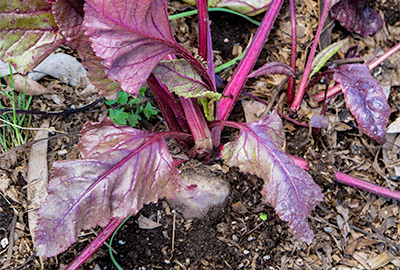
Harvest outer beet leaves as needed throughout the growing season, which allows the plant to produce new leaves over an extended period from growing point at the plant’s center. GardenZeus expert Darren Butler recommends generally limiting cutting to 10% to 20% of the leaves from any single plant during a given harvest period of 1 to 2 weeks, or 2 to 3 weeks if also planning to harvest the root. Cut the stalks or midribs of the largest, outermost leaves near the soil or as low as possible with inevitable crowding from other midribs, using a sharp knife or garden scissors.
Harvest beet roots when they reach your desired size, approximately 1.25 inches wide or smaller for baby beets, and generally before roots exceed 3 inches in diameter for mature roots. You may need to brush soil away from around beet roots or probe gently with your fingers to determine root size before harvesting.
In loose, light, and sandy soils, beets can often be pulled directly from the ground by grasping the beet at the base of the leaves and pulling firmly. In heavy and clay soils, it may be necessary to push a spading fork, trowel, or shovel into soil about 2 to 6 inches inches from the beet root(s) and gently loosen the soil before harvesting.
Harvesting Tips
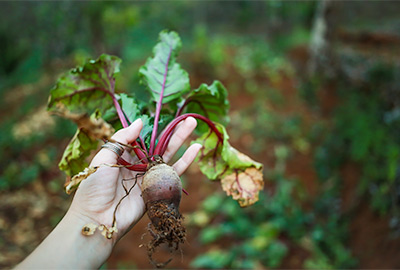
Harvesting beets is easier in moist soil; you may wish to water within 24 hours before harvesting.
What Commonly Goes Wrong
Cracked and split roots: Most often the result of uneven watering or periods of dry soil between waterings. Water uniformly.
Rotting roots: Usually the result of disease organisms that thrive in wet and anaerobic soils, but can occur in a range of soil conditions. Provide better drainage and/or reduce watering. Rotate crops and avoid planting beets repeatedly in the same soil, or in soil where chard, spinach, or other relatives were grown within the past 2 to 3 years. Encourage a healthy, living soil ecosystem that will help keep soil diseases in check.
Tough, hard, fibrous, woody, small, forked, or poorly shaped roots: These conditions occur in tough, compacted soils, in rocky or obstructed soils, when beets are overcrowded, when grown in hot weather or under dry conditions, or when allowed to grow overmature and left too long unharvested. These conditions can also occur as a result of transplanting rootbound beet starts too long after germination, in soil with pH that is too high or too low, or as a result of nutrient deficiencies or toxicities in soil.
Bolting: Beets may begin to flower and go to seed as a result of water stress, repeated wilting, hot or cold weather, other stresses, or naturally as a result of their biennial reproductive cycle. Beets are known to bolt when exposed to extended periods of 2 to 3 weeks or longer at cool to cold temperatures below 50° F. Leaves may turn bitter and root quality may decline rapidly after beets start to flower. There is nothing that can be done to reverse or stop bolting once it begins. GardenZeus recommends harvesting entire beet plants at the first sign of bolting, unless you want to save seeds.
Slow growth, lack of vigor, small or stunted plants, production of few or small leaves, yellowing leaves, dried-out or folded edges of leaves, brown or dead leaf tips or edges: These common symptoms may result from soil pH that is too high or too low, compacted soil, alkaline soil, overwatering, underwatering, irregular watering, cold or hot weather, planting rootbound transplants, lack of soil nitrogen, other soil nutrient deficiencies, or a combination of these. May also be the result of too much sun, wind, or other environmental and abiotic factors. Burned leaf tips may also result from overfertilizing, sodic soils, or soluble salts in soils.
Poor root color: Beets may form white bands or poor root color as a result of hot temperatures. Pigment develops best in beet roots when days are cool-to-warm, or intermittently warm and cool, and nights are cool. Grow beets as a cool-season crop only, and harvest entire plants before hot weather arrives.
Not a Problem
As beet roots swell and mature, they sometimes literally begin to push themselves out of the soil. It's not generally a problem to have a significant portion of a beet root exposed above soil, although under hot, sunny conditions this may cause the roots to become tough and less palatable, and in some cases, beets may actually push themselves so far out of soil that they fall over.
Many gardeners prefer to mound soil around exposed beets or cover with mulch. It's generally true with plants that an exposed root crown is stressful and can be fatal. GardenZeus expert Darren Butler has found that maturing beets generally are fine with exposed upper roots, and he believes that it is actually better to have beet roots partially exposed than to have moist mulch or organic matter packed against roots, as the latter may encourage disease pathogens. Generally, when growing beets during cool weather and when their cultivation needs are otherwise met, Darren has not seen root quality affected negatively when top portions of beet roots are exposed above soil level.
Common Diseases
Damping Off: Caused by soilborne fungi that may suddenly kill smaller seedlings and starts. Occurs most commonly in cool, damp soils.
Various bacteria and fungi may cause rot and kill plants, especially in wet soils. Dry out soils, encourage a healthy soil ecosystem, plant in beds or soils with better drainage, and avoid planting beets and relatives in the same area for at least 2 to 3 years.
Mildews: Powdery and downy mildew appear as a whitish circles or whitish layers on the upper or lower surfaces of leaves, yellowing or dead spots, or pale or yellow angular leaf sections, and may be mistaken for other problems, such as nutrient deficiencies. Avoid wetting foliage when watering. Some mildews can be discouraged using a nontoxic homemade spray of one tablespoon each of baking soda and tea tree oil per quart of water, shaken vigorously and regularly as applied via spray bottle. Mildews are often difficult to control and are best managed through prevention and good cultural practices, such as planting resistant varieties, planting in areas with good air circulation, keeping foliage dry, less-frequent irrigation, encouraging biologically active "living" soil that will support strong plant immune systems, and rotating crops. Mildews are often not fatal and beets may produce reasonable yields of fresh uninfected leaves despite ongoing infections on older leaves. Mild infections of mildew on beet leaves do not normally affect beet root quality, but severe infections during warm-to-hot weather or over long periods can cause root quality to decline.
Beets are sensitive to boron deficiency. Boron deficiency can occur in beets even when sufficient boron is present in soils, particularly at high pH levels. Boron-deficient beets are often stunted and develop cracked roots and black spots or areas on the surface and internal parts of the roots, stunting planting growth. If you suspect boron deficiency, test your soil and maintain a soil pH below 7.0.
Common Pests
Common pests of beets include aphids, leafhoppers, earwigs, nematodes, flea beetles, grasshoppers, leafminers, webworms, spider mites, whiteflies, slugs, snails, gophers, rabbits, and deer.
Aphids can often be washed off plants with a strong stream of water. They have many beneficial insects that are natural predators. Often aphid problems coincide with Argentinian ant infestations because ants move aphids to uninfected leaves and protect aphids from predatory insects. Use a boric-acid ant bait to control ants. Aphid problems may persist as long as Argentinian ants are present.
Webworms are the caterpillars of brown, nocturnal moths. They skeletonize leaves, spinning a web that draws leaves together to create homes on a wide variety of vegetables and other plants. Rows of eggs of the webworms may be visible on the underside of the leaves. Remove webbed leaves and caterpillars.
Flea beetles feed on young leaves, leaving small holes in the leaves. They are difficult to control in home gardens, but often cause minor to moderate damage only. Remove nearby weed patches and cover young beet plants with floating row covers or lightweight cloth sheets.
Leafminers are tiny insects whose larvae tunnel between the upper and lower surface of leaves. They can be difficult to control, and are best kept in check by natural predators. Encourage beneficial insects in your garden by planting pollen-and-nectar-producing flowering plants. Remove nearby weed patches that might include host plants, and remove severely infested leaves.
Special Care
Plant extra beet seeds 2 to 3 months before the end of your cool season to produce a large harvest at the end of the season, that with proper storage will allow you to eat garden beets well into summer or even fall.
Special Info
Vegetable juice enthusiasts may be interested in beets primarily for their leaves, which for some are a staple for fresh, raw vegetable juicing. GardenZeus expert Darren Butler observes that there are many paths to becoming a gardener, and he believes that it is merely a hop, skip, and a jump from being a veggie juicer to becoming a beet-leaf gardener, and from there, in no time at all, you may be growing tomatoes and giant pumpkins.
Anyone who eats, juices, or cooks with beet leaves but does not favor cooking or eating the roots, may find that they regularly discard unused beet roots. It this describes you, try replanting the healthiest, firmest beet roots in your garden as soon as possible after purchasing them, or start with a single large planting pot filled with a mixture of sand and potting soil. Space replanted beet roots closely with just a couple of inches between each root. In reasonably fertile soil, if supplemented once or twice per month with nitrogen, replanted beet roots will produce new leaves for several weeks to several months during cool weather and in mild climates before bolting or expiring.
Out-of-this-World beets: During the 1975 Apollo-Soyuz Test Project, cosmonauts from the USSR’s Soyuz 19 shuttle welcomed the Apollo 18 crew by preparing beet soup (borscht) in zero gravity.
Sustainable Landscaping Tip
Beets are not good candidates for naturalizing because they cross-pollinate easily with chard and other beet varieties, and they need more moisture than is often provided by natural winter rainfall in in many areas of California to form large, tender roots. Beets are not as good at breaking up tough soils as other root crops, such as fodder radishes, and unless your soil is deep, fertile, and full of life, it is difficult to grow high-quality beets without irrigation and attentive cultivation. As nutritional powerhouses, beets may be better at sustaining you than your landscape!
Advanced Tip
If saving seeds, be sure that only one variety of beets or chard is flowering in your garden at one time. Seed quality may be variable depending upon whether or not other beets are flowering at the same time in nearby gardens. For good quality seeds, beets should be hand-pollinated.
Beets are biennial and require a cold period before flowering and setting seeds. This is provided most efficiently in your zone by harvesting roots of the best quality, mature beets, removing tops, and storing them under cold, humid conditions for several weeks to approximate winter.
Humidity in refrigerators is too low for long-term beet storage; roots may last weeks to a month or two, but eventually will dry up, soften, and shrivel, especially small roots or baby beets whose surface area is disproportionately greater as compared with larger beets. If storing beets in your refrigerator, do so in a humid produce drawer with an open bowl of water, and/or in cloth or paper bags to reduce drying. If storing beets in a refrigerator for later seed production, you may also wish to hydrate your beet roots by placing a few beets in a bowl with cold water inside the refrigerator for a a couple of hours at a time every 10 to 14 days. This will degrade their quality for eating, but will prolong life for replanting. After providing a cold period to beet roots, replant them outdoors, ideally in late winter to early spring in your zone.
Preservation, Storage, and Use
Beets store exceptionally well; they last for a few to several months under ideal conditions of 32° F and high humidity. To extend storage life of roots, remove tops and cull out all diseased or injured roots that might spread infection to others. Wash all soil from roots and allow to dry thoroughly.
Humidity in refrigerators is too low for long-term beet storage; roots may last weeks to a month or two, but eventually will dry up, soften, and shrivel, especially small roots or baby beets whose surface area is disproportionately greater as compared with larger beets. If storing beets in your refrigerator, do so in a humid produce drawer with humidity turned up to full, or with an open bowl of water, and/or in cloth or paper bags to reduce drying.
Beets are not sensitive to the ethylene gas produced by many of the fruits in your refrigerator.
The sweet yet earthy taste of beets makes them a popular cooked vegetable. Beets can be pickled, or used in relishes or chutneys. Small beets can be steamed whole for use in fresh salads. And while opinions about how beets taste best will necessarily vary, GardenZeus co-founder Ann Clary believes that beets taste best after roasting at a relatively high heat of 450° F, which caramelizes beet sugars.
While most commonly used for cooking and fresh eating, beets are also medicinal, and are used as a natural food coloring, both in the home kitchen and in commercially processed foods. They contain tryptophan, which can help to relax the mind; and betadine, which naturally treats depression, reduces inflamation, and cleanses the liver. Beets also contain nitrates that can help to lower blood pressure and boost stamina. They have been used for folk and herbal remedies and treatments for hundreds of years.
Beets have been used by many cultures throughout history as an aphrodesiac, beginning with the ancient Romans, the first culture that cultivated them. Modern science links the high levels of boron in beets to increases in the production of human sex hormones. While not a sex therapist by any stretch of reality or imagination, unless you count resolving issues with plant pollination, GardenZeus expert Darren Butler believes that beets can support healthy sexual functioning, especially when combined with a overall good nutrition and a holistic lifestyle.